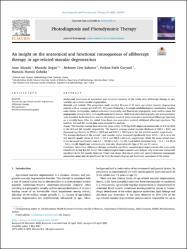An insight on the anatomical and functional consequences of aflibercept therapy in age-related macular degeneration
Künye
Alizada, A., Dogan, M., Sabaner, M. C., Gulyesil, F. F., & Gobeka, H. H. (2021). An insight on the anatomical and functional consequences of aflibercept therapy in age-related macular degeneration. Photodiagnosis and Photodynamic Therapy, 34, 102307.Özet
Background
Evaluation of anatomical and functional recovery of the retina after aflibercept therapy in neovascular age-related macular degeneration.
Materials and methods
This prospective study enrolled 33 eyes of 33 naive age-related macular degeneration patients with an average age of 69 (55−82) years. Following a thorough ophthalmological examination, baseline color fundus photography, optical coherence tomography and fluorescein angiography were used to assess the angiographic characteristics and classification of the lesions. Multifocal electroretinography and microperimetry were recorded. In the first three months, all patients received three consecutive intravitreal aflibercept injections on a monthly basis. After the initial three doses, non-responders received additional afibercept injections. The baseline, 3rd and 6th month data were recorded for analysis.
Results
The baseline average best-corrected visual acuity (1.05 log MAR) improved dramatically to 0.9 log MAR in the 3rd and 6th months, respectively. The baseline average central macular thickness of 358.5 ± 232.1 μm decreased significantly to 273.0 ± 109.9 μm and 245.5 ± 109.3 μm in the 3rd and 6th months, respectively.
The average thickness of the central 1 mm macular region decreased significantly from 349.5 ± 96.4 μm to the 3rd and 6th month values of 320.6 ± 101.9 and 290.5 ± 86.4 μm, respectively. While the mean retinal sensitivity increased significantly from 4.7 ± 3.0 dB to 6.9 ± 3.4 Db, local deficit decreased from −11.6 ± 4.6 dB to −9.4 ± 4.6 dB. Significant improvements were also observed in all rings of N1 and P1 waves.
Conclusion
Intravitreal aflibercept therapy resulted in significant morphological improvements that were easily identifiable during the 3rd month. Electrophysiological improvements were delayed only to become statistically significant in the 6th month. However, it has been shown that visual acuity and optical coherence tomography parameters alone may be insufficient for both the morphological and functional assessment of the retina.
















